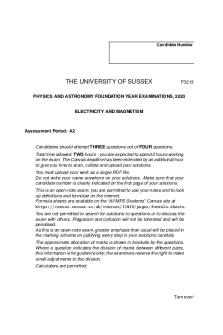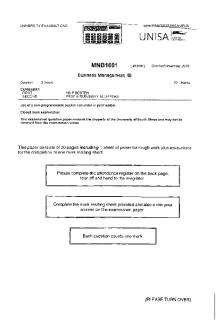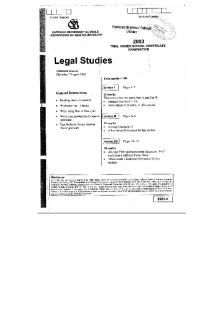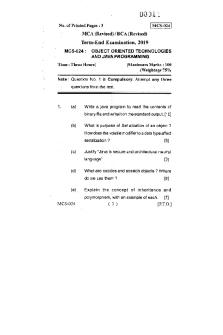Psychology6211 past paper (2019 ) PDF

| Title | Psychology6211 past paper (2019 ) |
|---|---|
| Author | Loyiiso Mahongwe |
| Course | Personality Psychology |
| Institution | Varsity College |
| Pages | 3 |
| File Size | 205.6 KB |
| File Type | |
| Total Downloads | 81 |
| Total Views | 185 |
Summary
Practice material to help get better marks on your assignments...
Description
17; 18; 19
2019
MODULE NAME:
MODULE CODE:
PSYCHOLOGY 2A: SOCIAL PSYCHOLOGY
PSYC6211
ASSESSMENT TYPE:
TEST (PAPER ONLY)
TOTAL MARK ALLOCATION:
60 MARKS
TOTAL HOURS:
1 HOUR (+5 minutes reading time)
INSTRUCTIONS: 1. Please adhere to all instructions in the assessment booklet. 2. Independent work is required. 3. Five minutes per hour of the assessment to a maximum of 15 minutes is dedicated to reading time before the start of the assessment. You may make notes on your question paper, but not in your answer sheet. Calculators may not be used during reading time. 4. You may not leave the assessment venue during reading time, or during the first hour or during the last 15 minutes of the assessment. 5. Ensure that your name is on all pieces of paper or books that you will be submitting. Submit all the pages of this assessment’s question paper as well as your answer script. 6. Answer all the questions on the answer sheets or in answer booklets provided. The phrase ‘END OF PAPER’ will appear after the final set question of this assessment. 7. Remember to work at a steady pace so that you are able to complete the assessment within the allocated time. Use the mark allocation as a guideline as to how much time to spend on each section. Additional instructions: 1. This is a CLOSED BOOK assessment. 2. Calculators are not allowed. 3. Answer All Questions.
© The Independent Institute of Education (Pty) Ltd 2019 Page 1 of 3
17; 18; 19
2019
Question 1
Q.1.1
(Marks: 15)
Evolutionary psychology suggests that our species possesses a number of evolved
(5)
psychological mechanisms that play a role in survival. Evolution involves three basic components, one of which is variation. Identify and explain the other two basic components.
Q.1.2
With the use of an example, explain how para-language is used as a non-verbal
(5)
cue in social interactions.
Q.1.3
You are walking along the sidewalk when you see another person trip and fall, and
(5)
you think about how clumsy they are. A few minutes later, you also trip and fall, but you attribute your fall to a puddle of water on the sidewalk. Identify and explain the type of attribution bias that has occurred in this scenario.
Question 2
Q.2.1
(Marks: 15)
Our need for affiliation is seen as a basic element of our wellbeing. However,
(5)
people differ in the strength of this tendency. Discuss the importance of individual needs to affiliate among human beings by making reference to research conducted.
Q.2.2
Research suggests that we tend to like those who are similar to us but dislike
(5)
those who are different. Outline and apply Festinger’s social comparison theory to explain why we seek out individuals who are similar to us.
Q.2.3
Our attachment style has been linked to the development of positive relationships
(5)
with family members. Define the concept of attachment style as outlined by Bowlby (1969) and list four of these attachment styles.
© The Independent Institute of Education (Pty) Ltd 2019 Page 2 of 3
17; 18; 19
2019
Question 3
Q.3.1
(Marks: 15)
Groups consist of several basic features that are present in virtually every
(5)
group. With the use of an example, explain the feature of roles and the differentiation of functions within groups.
Q.3.2
With the use of an example, discuss faulty attributions and their role in
(5)
addressing conflict.
Q.3.3
Research on perceived fairness in group settings indicates that we generally
(5)
make judgments of fairness by focusing on three aspects. Explain the rule of distributive justice by making use of an example to illustrate your answer.
Question 4
Q.4.1
(Marks: 15)
Explain how the Realistic Conflict Theory can account for xenophobic or
(5)
prejudicial behaviour among groups. Please make reference to research that has been conducted in this area in order to substantiate your answer.
Q.4.2
Explain, with an example for each, the concepts of prejudice, stereotyping and
(10)
discrimination.
END OF PAPER
© The Independent Institute of Education (Pty) Ltd 2019 Page 3 of 3...
Similar Free PDFs

ANAT2004 2019 past paper
- 16 Pages

SBL Past Exam Paper 2019
- 20 Pages

Jan 2019 N1589 - Past paper
- 2 Pages

Uob past paper
- 4 Pages

Legal Studies Past paper
- 18 Pages

STAT270 - past exam paper
- 24 Pages

Macroeconomics Past Paper
- 12 Pages

2020 F3213 - Past paper
- 5 Pages

Past exam Paper 2018
- 23 Pages

Trial past exam paper
- 7 Pages

MA103 Past Paper Exam
- 5 Pages

2010 exam - past paper
- 25 Pages
Popular Institutions
- Tinajero National High School - Annex
- Politeknik Caltex Riau
- Yokohama City University
- SGT University
- University of Al-Qadisiyah
- Divine Word College of Vigan
- Techniek College Rotterdam
- Universidade de Santiago
- Universiti Teknologi MARA Cawangan Johor Kampus Pasir Gudang
- Poltekkes Kemenkes Yogyakarta
- Baguio City National High School
- Colegio san marcos
- preparatoria uno
- Centro de Bachillerato Tecnológico Industrial y de Servicios No. 107
- Dalian Maritime University
- Quang Trung Secondary School
- Colegio Tecnológico en Informática
- Corporación Regional de Educación Superior
- Grupo CEDVA
- Dar Al Uloom University
- Centro de Estudios Preuniversitarios de la Universidad Nacional de Ingeniería
- 上智大学
- Aakash International School, Nuna Majara
- San Felipe Neri Catholic School
- Kang Chiao International School - New Taipei City
- Misamis Occidental National High School
- Institución Educativa Escuela Normal Juan Ladrilleros
- Kolehiyo ng Pantukan
- Batanes State College
- Instituto Continental
- Sekolah Menengah Kejuruan Kesehatan Kaltara (Tarakan)
- Colegio de La Inmaculada Concepcion - Cebu



